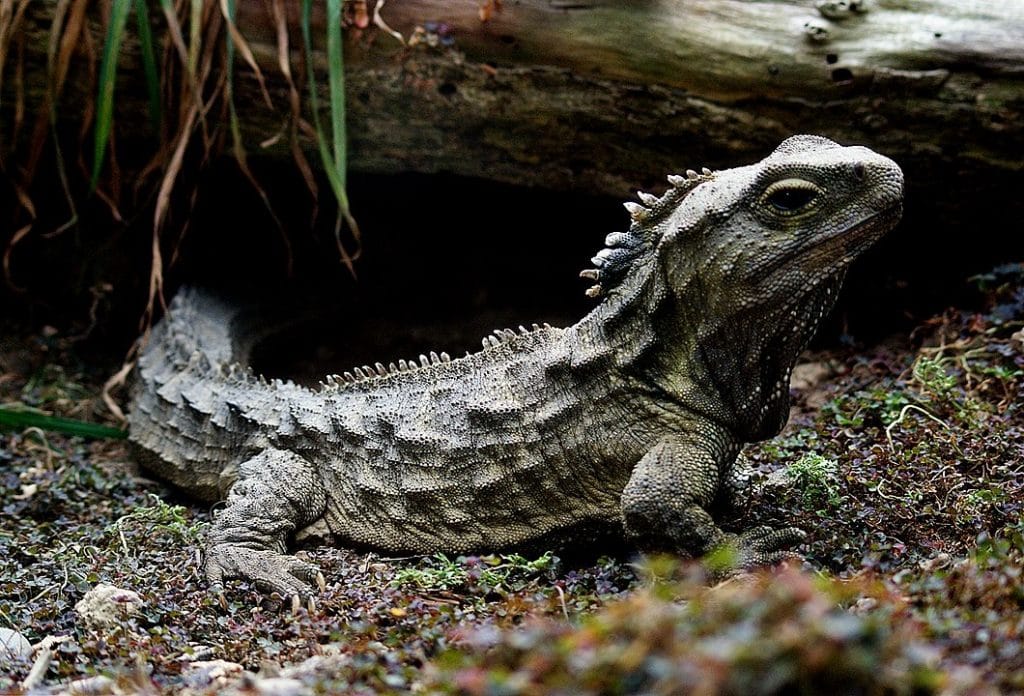A lizard-like creature whose ancestors once roamed the Earth with dinosaurs and today is known to live for longer than 100 years may hold clues to a host of questions about the past and the future.
In a study published Aug. 5 in Nature, an interdisciplinary, international team of researchers, in partnership with Māori tribe Ngātiwai, sequenced, assembled and analyzed the complete genome of the Sphenodon punctatus, or the tuatara, a rare reptile whose ancestors once roamed the earth with dinosaurs. It hasn’t changed much in the 150 million to 250 million years since then.
“We found that the tuatara genome has accumulated far fewer DNA substitutions over time than other reptiles, and the molecular clock for tuataras ticked at a much slower speed than squamates, although faster than turtles and crocodiles, which are the real molecular slowpokes,” said co-author Marc Tollis, an assistant professor in the School of Informatics, Computing, and Cyber Systems at Northern Arizona University. “This means in terms of the rate of molecular evolution, tuataras are kind of the Toyota Corolla—nothing special but very reliable and persistently ticking away over hundreds of millions of years.”
Tuatara have been out on their own for a staggering amount of time, with prior estimates ranging from 150–250 million years, and with no close relatives the position of tuatara on tree of life has long been contentious. Some argue tuatara are more closely related to birds, crocodiles and turtles, while others say they stem from a common ancestor shared with lizards and snakes. This new research places tuatara firmly in the branch shared with lizards and snakes, but they appear to have split off and been on their own for about 250 million years—a massive length of time considering primates originated about 65 million years ago, and hominids, from which humans descend, originated approximately six million years ago.

“Proving the phylogenetic position of tuatara in a robust way is exciting, but we see the biggest discovery in this research as uncovering the genetic code and beginning to explore aspects of the biology that makes this species so unique, while also developing new information that will help us better conserve this taonga or special treasure,” said lead author Neil Gemmell, a professor at the University of Otago.
One area of particular interest is to understand how tuataras, which can live to be more than 100 years old, achieve such longevity. Examining some of the genes implicated in protecting the body from the ravages of age found that tuatara have more of these genes than any other vertebrate species thus far examined, including humans. This could offer clues into how to increase humans’ resistance to the ailments that kill humans.
But the genome, and the tuatara itself, has so many other unique features all on its own. For one, scientists have found tuatara fossils dating back 150 million years, and they look exactly the same as the animals today. The fossil story dates the tuatara lineage to the Triassic Period, when dinosaurs were just starting to roam the Earth.
“The tuatara genome is really a time machine that allows us to understand what the genetic conditions were for animals that were vying for world supremacy hundreds of millions of years ago,” he said. “A genome sequence from an animal this ancient and divergent could give us a better idea about what the ancestral amniote genome might have looked like.”
While modern birds are the descendants of dinosaurs, they are less suitable for this type of research because avian genomes have lost a significant amount of DNA since diverging from their dinosaur ancestors.
But the tuataras, which used to be spread throughout the world, have other unusual features. Particularly relevant to this research is the size of its genome; the genome of this little lizard has 5 billion bases of DNA, making it 67 percent larger than a human genome. Additionally, tuataras have temperature-based sex determination, which means the ratio of males to females in a clutch of eggs depends on the temperatures at which they are incubated. They also have a pronounced “third eye”—a light sensory organ that sticks through the top of their skulls. Mammals’ skulls have completely covered the third eye, though they still contain the pineal gland underneath, which helps maintain circadian rhythms.
The tuatara also is unique in that it is sacred to the Māori people. This research, for all the scientific knowledge that came from it, was groundbreaking for its collaboration with the Indigenous New Zealanders. The purpose was to ensure the research aligned with and respected the importance of the tuatara in their culture, which has never been done before in genomic research.
“Tuatara are a taonga, and it’s pleasing to see the results of this study have now been published,” Ngātiwai Trust Board resource management unit manager Alyx Pivac said. “Our hope is that this is yet another piece of information that will help us understand tuatara and aid in the conservation of this special species. We want to extend a big mihi to all of those who have been involved in this important piece of work.”
With the genome now sequenced, the international science community has a blueprint through which to examine the many unique features of tuatara biology, which will aid human
understanding of the evolution of the amniotes, a group that includes birds, reptiles and mammals.
Heidi Toth | NAU Communications
(928) 523-8737 | heidi.toth@nau.edu




